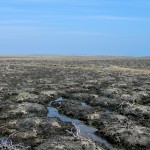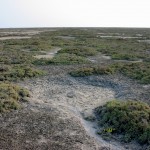The Oiled Shoreline Survey (OSS) was one of several studies conducted by the Presidency of Meteorology and Environment (PME) to determine the impacts of the 1991 oil spill resulting from Iraq’s illegal invasion and occupation of Kuwait on the environment and public health, with funding provided by the United Nations Compensation Commission (UNCC). RPI scientists planned and conducted this survey of almost 800 km of shoreline from the western end of Abu Ali Island to the Kuwaiti border.
After completing a review of the effects of oil spills on intertidal shoreline habitats in semi-tropical and tropical environments, and the scientific literature on the 1991 oil spill on coastal habitats along the Arabian Gulf shoreline of the Kingdom of Saudi Arabia, RPI’s task was to identify areas of shoreline of the Kingdom of Saudi Arabia that are still impacted by the 1991 oil spill. RPI conducted and extensive field geomorphic and ecological surveys and chemical sampling campaign to locate and describe visible oil residues on the surface and in the subsurface, and confirm these observations by Total Petroleum Hydrocarbons (TPH) and chemical “fingerprint” analysis of sediment samples collected during the surveys.
We then analyzed the temporal rates of natural oil removal and oil weathering by comparing data collected during this study in 2002 and 2003 with previous surveys conducted in 1992 and 1993, quantified the length, width, and depth of the oiled sediments and the overlying sediments free of visible oil, and evaluate the ecological health of the shoreline.


Oiled vs. unoiled arid marsh.
